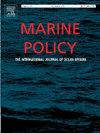海底电缆与帝国的扩张:英国、日本和美国的崛起以及连接夏威夷的竞争
IF 3.7
2区 社会学
Q2 ENVIRONMENTAL STUDIES
引用次数: 0
摘要
本文考察了从19世纪中期到20世纪中期海底电缆的历史。历史上地缘政治是如何影响电缆建设的?今天有什么相似之处?利用新的档案数据和日语资料,本文考察了英国、日本和美国的案例研究,以证明有线网络的建设在历史上是如何被新兴大国为了战略目的而寻求连接其领土和殖民地所塑造的,这有时会把夏威夷这样的小岛屿国家置于连接竞争的中心。地缘政治影响了这一时期有线电视网络的结构;在拥有共同殖民联系的国家之间,联系往往会激增,而国家之间的紧张局势和不信任阻碍了潜在的建设项目。当国家之间发生冲突时,有线电视网络会因蓄意破坏而中断,或者在某些情况下被允许废弃。本文通过将以前很少受到关注的数据纳入有关海底电缆历史的讨论中,并将英国、日本和美国的案例带入彼此的对话,从而对现有文献做出了贡献。尽管多年来技术和法律框架发生了变化,但这种通过海底电缆分析三个帝国主义大国霸权活动的历史方法所产生的发现对当代政策具有影响。本文章由计算机程序翻译,如有差异,请以英文原文为准。
Undersea cables and the extension of empire: The rise of Britain, Japan, and the United States and the competition to connect Hawai‘i
This article examines the history of undersea cables from the mid-19th century to the mid-20th century. How did geopolitics affect cable construction historically? What parallels exist in the present day? Drawing on new archival data and Japanese-language sources, the article examines case studies of Britain, Japan, and the United States to demonstrate how the construction of cable networks was historically shaped by rising powers seeking to connect their territories and colonies for strategic purposes, which sometimes put small island nations such as Hawai‘i at the center of competition over connectivity. Geopolitics influenced the structure of cable networks during this period; connections tended to proliferate among countries that shared colonial links, while tensions and distrust among countries stopped potential construction projects. When countries came into conflict with one another, cable networks were disrupted due to intentional sabotage, or they were allowed to fall into disuse in some cases. This article contributes to the existing literature by incorporating data that has previously received little attention into discussions about the history of undersea cables and by bringing the cases of the United Kingdom, Japan, and the United States into dialogue with one another. This historical approach to analyzing the hegemonic activities of three imperial powers through the lens of submarine cables yields findings that have implications for contemporary policy, despite changes in technology and legal frameworks over the years.
求助全文
通过发布文献求助,成功后即可免费获取论文全文。
去求助
来源期刊

Marine Policy
Multiple-
CiteScore
7.60
自引率
13.20%
发文量
428
期刊介绍:
Marine Policy is the leading journal of ocean policy studies. It offers researchers, analysts and policy makers a unique combination of analyses in the principal social science disciplines relevant to the formulation of marine policy. Major articles are contributed by specialists in marine affairs, including marine economists and marine resource managers, political scientists, marine scientists, international lawyers, geographers and anthropologists. Drawing on their expertise and research, the journal covers: international, regional and national marine policies; institutional arrangements for the management and regulation of marine activities, including fisheries and shipping; conflict resolution; marine pollution and environment; conservation and use of marine resources. Regular features of Marine Policy include research reports, conference reports and reports on current developments to keep readers up-to-date with the latest developments and research in ocean affairs.
 求助内容:
求助内容: 应助结果提醒方式:
应助结果提醒方式:


